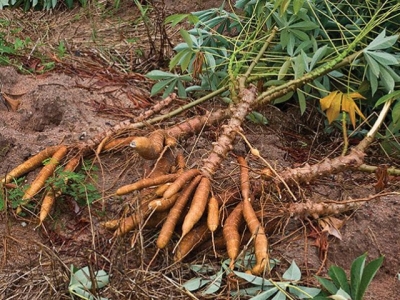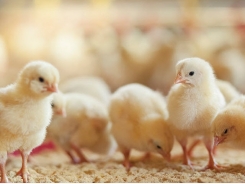6 alternative energy ingredients to feed broilers

Cassava is a starch-rich ingredient that is underutilized in commercial animal feeds. | Pixbox77, Dreamstime
Corn and wheat are staple energy sources worldwide, but not necessarily always the most profitable ones as local and opportunity ingredients can be used at advantage.
It is widely known that chickens will eat everything, and this was one of the major reasons why every farm house had its own chickens to feed kitchen scraps in exchange for eggs and meat. Modern broilers, however, cannot grow to their maximal genetic potential, or be as efficient, with mere kitchen scraps. But alternative feed ingredients abound, and although they take some knowledge to be used properly, they can lower feed costs for an industry that measures profitability in cents instead of dollars per head.
Corn and wheat are the two major sources of energy for broilers, worldwide. Corn is as “inert” an ingredient as possible to exist, with its only problem being the production of soft and yellowish carcass fat, which is not always a problem, and can even be a desirable trait for some markets. On the other hand, wheat does not have this problem, but it contains less energy and a good measure of undesirable non-starch polysaccharides that are best addressed by adding enzymes that further increase cost. Thus, even staple energy sources are not without their problems, but we have learned to live with them.
True savings come at a cost, and it is the balance that determines profitability.
Quite often, alternative energy sources become available, either through commerce or as an opportunity. Agro-industrial industries abound, human food industries produce subpar (for humans) batches of otherwise superb ingredients and oversupply often causes a plethora of ingredients to be disposed of at bargain prices. In order to take advantages of such opportunities, either occasionally or on a permanent basis, two basic conditions must be observed. The first is a relationship of trust with your supplier. This is true for all business transactions, but when it comes to alternative ingredients, it is not recommended to buy from anyone but the most reputable sources. Second is the employment of a nutritionist with considerable experience in using alternative ingredients. The advice offered freely by the supplier is often inadequate (think about the relationship you have with your doctor versus your pharmacist, and in this case it is not about a simple headache but for a serious issue). In other words, to best use alternative ingredients, one must address this issue, yes, as an opportunity, but also as a challenge. True savings come at a cost, and it is the balance that determines profitability.
To further this discussion, I am presenting six alternative energy sources that I have found of considerable value through experience with my own customers, worldwide. Not all are possible to be used at each farm, and indeed, some are to be excluded when others are available. But the wide coverage of possible ingredients serves as an idea of what can be found in the market.
It should be finally noted that quite often absolute growth performance might be reduced, but if the cost of alternative ingredients is low enough, overall farm profitability can decrease. This is why it is important to monitor not only feed efficiency and growth rate, but also cost of production per bird, pound of gain or square foot of broiler facilities. And, of course, profitability per batch remains the final arbiter of all.
1. Bakery meal
I have written extensively for this ingredient, and I will not cease to emphasize that it can be equally friend and foe. It can be composed from a myriad of starch- and fat-rich components such as pasta, cakes, bread, potato chips, sweets, etc. One needs to know the levels of salt, sugar, starch and oil/fat in order to not only use it properly in feed formulation, but also to evaluate its quality. Some products are better than others, not only because of superior quality, but also because of a more suitable mix of ingredients. In general, for broilers, a product with low levels of lactose and sugars should be avoided, whereas a high oil (with an added antioxidant) and starch content should be preferred.
2. High oil/fat levels
Oils and fats are expensive, but occasionally batches (of good quality) can become available at bargain prices. The same goes for less well-known sources of lipids such as soap stock, for example. It is possible to use higher than normal levels of added oils and fats in broiler diets, assuming carcass quality changes (if any) remain within acceptable levels. Off-quality oils and fats (rancid) will turn birds off feed and, as such, they should be avoided at any cost! The exact inclusion levels of added oils and fats depend on the maximum allowed not only by carcass considerations, but also by the mixing facilities of each broiler enterprise.
3. Tapioca (cassava)
Tapioca (cassava) is a product of Southeast Asia and other regions that is frequently imported in other countries as it has become an easily transported commodity. It can cause cyanosis, meaning birds will die of asphyxia, if not processed properly. This effect is more of a concern as inclusion levels increase, but normally commercially available cassava from international traders is of good to high quality. Otherwise, it is a high-starch ingredient, with nil protein levels that can replace (even totally) cereals. It takes some learning to use it as it requires grinding and dust control.
4. Minor cereals
Everything but corn and wheat can be considered a minor ingredient. Of those, only sorghum where it is raised instead of corn can be of an equal status to these two staple energy sources. Most alternative ingredients contain too much and too many non-starch polysaccharides that reduce energy digestibility, cause sticky droppings, and in general act as an anti-nutritional factor, albeit not a toxic one. Enzymes are used with more or less success to counter these anti-nutritional effects. When using minor ingredients, it is best to use a mix of them, or small quantities in conjunction with a major cereal or other energy source. Knowing the source of such ingredients is often enough for a nutritionist to determine their quality and how to best adjust their use in combination with enzymes and other additives or ingredients.
It must be remembered that soybeans are not grown for their protein content, but for their oil.
5. Full-fat soybeans
Soybean meal is the primary protein source for most animal diets worldwide, and this makes soybeans an unlikely source of energy. However, it must be remembered that soybeans are not grown for their protein content, but for their oil. They contain as much as 38 percent oil in their natural, dried form. Thus, when whole soybeans are available, using them can provide a source of energy in the form of “encapsulated” lipids that are not as prone to oxidation as lipids in oils and fats. In most cases, full-fat soybeans are extruded to reduce the anti-nutritional factors present in soybeans; the same applies to soybean meal that is being toasted. Extruded full-fat soybeans are usually an expensive ingredient, but if they are home-grown and processed through an inexpensive cooking outlet, then they can become and interesting source of energy and protein.
6. Molasses
It is unlikely to consider molasses for broiler feeds, but there is nothing negative in this ingredient, apart from being a semi-liquid ingredient that requires special handling. When molasses already exists as an ingredient in any feed mill, then there is no reason why a certain amount cannot be used in broiler feeds. It even has some extra benefits in terms of feed manufacturing, and as such it can become a standard ingredient in many broiler formulas. As for the exact inclusion rate, this is strictly determined by feed mill capabilities. Cane molasses is as good — or as troublesome — as beet molasses, and both impart a sweet flavor to feeds, along with a good portion of sucrose and fructose.
The above should not be considered as an exclusive list of alternative energy sources but rather as examples of what are available. True, it is easier to formulate a corn-soy diet rather than having to learn the intricacies of each alternative ingredient, and even go down to the feed mill floor to check quality and adjust manufacturing processes, but more often than not, this will pay off, especially if the feed mill is part of an integrated broiler enterprise.
Có thể bạn quan tâm
Phần mềm

Phối trộn thức ăn chăn nuôi

Pha dung dịch thủy canh

Định mức cho tôm ăn

Phối trộn phân bón NPK

Xác định tỷ lệ tôm sống

Chuyển đổi đơn vị phân bón

Xác định công suất sục khí

Chuyển đổi đơn vị tôm

Tính diện tích nhà kính

Tính thể tích ao hồ



 Broiler super pre-starter formulation secrets revealed
Broiler super pre-starter formulation secrets revealed  How to formulate low-protein diets for pigs, poultry
How to formulate low-protein diets for pigs, poultry